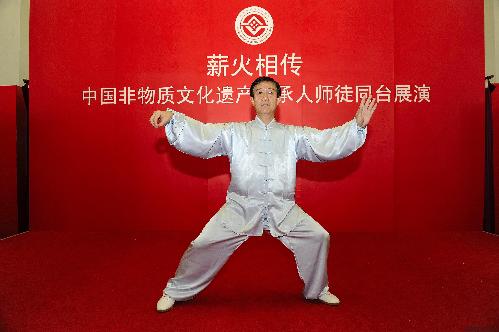|
 |
|
(SHI GANG) |
While the panda protagonist in this summer's Kung Fu Panda 2 may be a "dragon warrior," his defeat over his enemy is anything but fiery: the xiongmao finds inner peace and uses taiji to deflect gunfire. This cinematic choice echoes the Chinese martial art's philosophy. In taiji, the soft and pliable can defeat the hard and strong.
Taiji's rise
Taiji, a form of kungfu, has a multitude of training forms. But all of them can be traced back to central China's Henan Province, where the Chen style of the martial art reigns.
According to historical records, in late Ming (1368-1644) and early Qing (1644-1911) dynasties, a man named Chen Wangting combined kungfu with the theory of body's meridians and the theory of yin and yang found in The Book of Changes, a Chinese classic on divination. The fusion resulted in the Chen style of taiji, which further developed into five major schools of the martial art: Chen, Yang, Wu, Wu (Hao) and Sun. In 1984, Chen practitioners began to recruit against ancestral code that allowed "only for male family members" to practice taiji. The school ultimately developed a nationwide following. As exchange between China and the West began to increase, taiji found itself on the world stage. It's estimated that at present there are nearly 300 million taiji followers in more than 150 countries.
"Taiji is more than a sport. It's culture expressed through body," says Chen Zhenglei, an 11th generation member of the Chen family. Although taiji was created 300 years ago, its backbone, yin-yang theory, has a history of more than 5,000 years. Moreover, Chinese Confucianism, medicine, martial arts and etiquette have all been influenced by taiji. Taiji in many ways is a window to understanding Chinese culture.
Longevity & possibilities
Taiji is the most popular of China's 129 "fist techniques." Song Peiwen, a 79-year-old Beijing resident, practices the martial art in the park daily. Although her back is stooped, Song is still easy with movement. She has been practicing for 20 years. "I began to learn taiji during my retirement, and practice it every morning when the weather is nice," she says. "To practice solo form can maintain flexibility through your joints. If you repeat it for 15 minutes, all your joints can move for a while, and you will feel vital all day long."
Like Song, most people practice taiji for health reasons. Chen, who has been teaching since 1970, has students from around the world. He believes that most students, whether Chinese or foreign, embrace the martial art for its health benefits rather than for self-defense. But, he warns, "If taiji is not practiced for defense training anymore, its culture will be lost sooner or later. Taiji is not only about health maintenance. Through more practice you can reach a higher level to defend yourself against violence."
Chen attributes the widespread popularity of taiji to its lack of limitations. It can be fast or slow, hard or soft. For older people, slow and soft movements will help to build their bodies and cultivate their minds. Young people can learn its combative kungfu aspects through traditional exercises.
Unlike Western boxing, taiji focuses on bringing about a state of mental calm and clarity through movement. This pursuit of a harmonious relationship between body and mind is integral to Chinese ideas about health. It is also tied to traditional philosophies linking man and nature. "There are so many taiji fans all over the world because people are obsessed with its cultural appeal. Through practice, everyone can approach Chinese culture," explains Chen. "But then they will find that to be a good learner, they must have a further understanding of Chinese culture." |